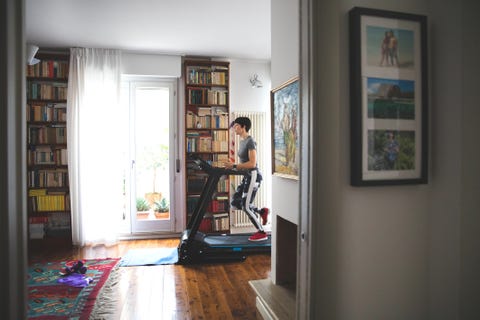Running's simplicity is a big part of its appeal. You don’t need a ton of gear to get started — some workout apparel and quality shoes will do — and you can essentially train anywhere … even indoors.
But deciding on whether to log your miles under the sun or under your own roof can spark a huge debate amongst athletes begging the question, which is better? Running on a treadmill or running outside?
The answer, in actuality, is more complicated than you’d expect.
Each running scenario has its perks, and both can deliver a worthwhile cardio session. But alas, a winner must be crowned, right? So, let’s lace up and head out — err, in — to settle this dispute once and for all.
Running Outside — The Pros
There's endless variety.
Outside of athletic tracks, there’s few running routes that are completely identical. Each have their own unique twists and turns, and you’ll need to navigate them accordingly as you stride from A to B. You’ll also have to traverse across various inclines and declines, too, all while adapting to the terrain you experience underfoot.
Sure, this may paint running outside as this complicated Rubik’s cube of a workout, but in reality, this variety is good for your training. All those turns and changes in direction can be great for working your lateral stabilizers in the knees, hips and ankles, leading to stronger performance at these key joints. The varying routes can also be excellent for targeting pace management, stride change, footstrike and other more intricate skill sets within your running gait. You’ll especially benefit from these sharpened skills if you have a race or marathon in your near future, as well.
Being outside is good for your brain.
When you run outside, you're not just benefitting from a great cardiovascular workout — you're also reaping the health benefits that come from nature. Fresh air and vitamin D from the sun can improve your overall well-being, according to studies.
There's plenty of mental aspects that one can improve with a simple outdoor jaunt, too. A 2017 study published in Frontiers of Psychology states outdoor training may help reduce anxiety, relieve stress and improve cognitive function. Getting out for a quick jog can also be a great way to escape from the daily grind. Tough day working from home? Hit the streets and unplug for a few miles — it’s a much better change of pace than swapping your monitor for a treadmill display.
Outdoor running may burn more calories.
Okay, this benefit is concretely backed by evidence, but if you think about your running conditions outside versus indoors, it’s a more difficult training scene. You’re dealing with those aforementioned inclines and declines, along with wind resistance, changes in temperature and other outside factors (pun intended). To complete your run with these challenges in-tote, you’ll need to put a little more effort into your strides. More effort means more energy, and thus, a higher caloric burn — science!
This isn’t to say that you can’t change your pitch and speed while running on a treadmill, but you need to manually alter these settings more often than not. If you’re pacing along for a workout, you may be more inclined to just cruise at the settings you have in place, whereas outdoor running makes you deal with the factors head on.
You're also more inclined to run further outside than you are indoors. You're essentially exploring as you train, looking around at newfound sights and scenery — or taking a wrong turn and adding a mile to your route. When you run on a treadmill, you can be less motivated about what's ahead since your scenery never changes, focusing more on hitting a mileage or time total without that sense of intrigue.
Running Outside — The Cons
Weather can be an issue.
Naturally, running outside places you in the elements … and they’re not always in your favor. There’s the chance of rain and inclement weather, which is never a factor when it comes to treadmill running (if it is, I’d recommend calling a plumber). Sure, you can layer up with a water-resistant jacket and some durable, grippy shoes, but a big part of training is being comfortable in your environment. Signing up for a few miles in a windstorm or downpour is not the most enticing ordeal.
Outside of weather, you also need to consider what time of day you’ll be running at. If your schedule forces you to run at night, you need to have complete confidence in your route, along with the proper gear to keep you visible to oncoming traffic. Nighttime running is doable, but it’s a lot easier to flick on a light at home than it is to try and navigate by headlamp through your neighborhood.
It's harder to control your pace outdoors.
Because you're changing directions, stopping for traffic, dealing with the elements and other factors, it can be difficult to maintain a desired pace when running outside. While you can monitor your stats through a smartwatch, fitness tracker or other device, your data points aren't directly in front of you like they are on a treadmill (well, not always). If you're not constantly monitoring these numbers, it can be difficult to maintain a desired speed or heart rate without plenty of practice and route knowledge. Even then, especially for athletes running in a city environment, it's near impossible to plan for a rogue red light or packed sidewalk.
Road running can be harder on your joints.
Running is a load-bearing workout that can put a lot of stress on the body, and the surface you run on plays an important role in just how impactful those stresses can be. While running shoes have come a long way, providing comfort and cushioning underfoot for a more enjoyable running experience, you're still pounding the hard, solid pavement or uneven trailway with each step. This impact can put more strain on your knees, ankle and hips, causing discomfort especially for those unaccustomed to running or those taking on longer routes. While you can alleviate some of this joint stress by running outside on softer trails or grass, not everyone has access to these surfaces.
Running on a Treadmill — The Pros
There's no need to plan for negative forecasts.
The best thing about treadmill running is that it can be done at any time of day without fear of overcast or inclement weather. You're able to comfortably log your miles from a well-sheltered room — no running jackets or headlamps required. You even have the power of setting the temperature to your liking if running on your at-home treadmill, giving you complete control of your running conditions.
Running on a treadmill can also be a great way to multitask or add other components to your training regimen. Because you’re not on some far-off trail, you’re able to quickly transition into a strength training session or post-workout yoga flow. Additionally, you’re more capable of getting back into your daily schedule when running indoors. Work emails and family matters are just a room away — a far shorter distance than miles out in your neighborhood or on the trail.
Controlling your pace is a breeze.
When you run outside, you need to consider how the elements affect your pace. If you want to run an unbroken length without any stops or changes, you need to choose your routes wisely — and pray you don't hit a stoplight.
All those variables go out the window when running on a treadmill. You're in full control of the belt's speed and incline, allowing for unbothered pacing throughout your entire jog. If you want to speed up or slow down, all that's required is a few toggles of the settings.
Treadmills can easier on your joints.
The vast majority of today's top treadmills feature cushioned running decks that are better suited for absorbing the shock and impact of each footstrike. This can create a softer landing under each step, taking away some of the discomfort you may feel in your joints.
While you can't eliminate all of the load-bearing movements of running, these softer running decks can help lessen the blow, which is why treadmill running is favored by those with sensitive joints, as well as those coming back from an injury. The constant deck surface is also great for newcomers, since you don't have to worry about uneven terrain or changing direction.
If treadmill running sounds enticing, here are a handful of our favorite silhouettes:
NordicTrack Commercial 1750
Horizon Fitness T101
LifeSpan TR5500iM Folding Treadmill
Running on a Treadmill — The Cons
There's limited variety in your routes and training.
While running on a treadmill is a great way to tally your miles indoors, it's just that — running indoors. You're locked into straightforward strides without any deviation or change of direction. If you're just wanting to get a run in, this can be more than suitable, but if you're training for a road race or want some sense of lateral movement, you're often left wanting more.
Additionally, changing up your incline or decline pitch is more involved when pacing atop a treadmill. Some brands do offer platforms with variable ascensions and descensions, but the feature isn’t necessarily standard across the entire category. Plus, it can take a few seconds for the belt to reach your desired angle, which isn’t as smooth as, say, tackling a rolling pathway or downhill sidewalk.
Treadmill running can get boring quickly.
An easy way to describe running outside versus treadmill running is to see it through the eyes of your pet. Outdoor running is like a trip to the dog park — plenty of room to roam and a lot of ground to explore. Treadmill running, on the other hand, is a hamster wheel — the same track, the same spot. Round and round until the training has ended.
As such, it’s easy to get into a training rut if you’re solely running indoors. Sure, you can try and combat this dilemma with a new playlist or open windows, but there’s more opportunity for excitement when your running shoes hit the pavement rather than that rubber belt.
Treadmills are an added expense to your training ensemble.
Running is a simple activity that doesn't require a lot of investment. Sure, premium running shoes and apparel can begin to add up, but you're more than capable of building a well-rounded setup for less than a few hundred dollars. That budget can easily get destroyed, however, if you decide to add a treadmill to your home decor.
Outside of the heavy cost, treadmills are also downright heavy pieces of equipment. Their bulky frames can be difficult to move around your house, and you need to sacrifice a good amount of floor space to house them within your abode. Some models may fold vertically for more compact storage, though, to help ease this issue.
Lastly, while you don't have to deal with safety factors like visibility and oncoming cars when treadmill running, they're still some risks associated with the discipline. Because of the moving belts and motors, you need to pay attention to the device, especially with pets and children in the household. Treadmills can pose serious risks — more than 22,000 individuals were treated for treadmill-related incidents in 2019 alone, according to The Washington Post.
Running on a Treadmill vs. Outside — The Verdict
Running outside or running on a treadmill can be great for your workout regimen, and there’s no true right or wrong answer between the two. Each have their own pros and cons, so in the end, the winning environment is the one that suits your schedule and preferences best. You can even combine the two throughout your fitness journey, so there’s no excuse to miss your weekly miles.




























